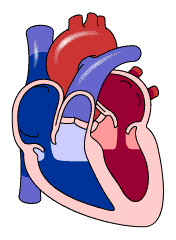resources


resources


Tuesday, September 1, 2009
Overview
Congenital heart disease refers to a problem with the heart's structure and function due to abnormal heart development before birth. Congenital means present at birth. Congenital heart defects may produce symptoms at birth, during childhood, and sometimes not until adulthood.
Congenital heart disease occurs while the fetus is developing in the uterus and it affects 8-10 out of every 1,000 children. About 500,000 adults in the U.S. have congenital heart disease.
Symptoms of Congenital Heart Disease in Children
The symptoms of congenital heart disease in infants and children include:
•Cyanosis (a bluish tint to the skin, fingernails, and lips)
•Fast breathing and poor feeding
•Poor weight gain
•Recurrent lung infections
•Inability to exercise
Symptoms of Congenital Heart Disease in Adults
Congenital heart disease may be diagnosed before birth, right after birth, during childhood, or not until adulthood. It is possible to have a defect and no symptoms at all. In adults, if symptoms are present, they may include:
•Shortness of breath
•Limited ability to exercise
Treatment
Treatment is based on the severity of the congenital heart disease. Some mild heart defects do not require any treatment. Others can be treated with medications, procedures, or surgery. Most adults with congenital heart disease should be monitored by a heart specialist and take precautions to prevent endocarditis (a serious infection of the heart valves) throughout their life.
Causes
Congenital heart disease (CHD) can describe a number of different problems affecting the heart. According to the American Heart Association, about 35,000 babies are born each year with some type of congenital heart defect. Congenital heart disease is responsible for more deaths in the first year of life than any other birth defects. Many of these defects need to be followed carefully. Some heal over time, others will require treatment.
While congenital heart disease is present at birth, the symptoms may not be immediately obvious. Defects such as coarctation of the aorta may not cause problems for many years. Other problems, such as a small ventricular septal defect (VSD), may never cause any problems, and some people with a VSD have normal physical activity and a normal life span.
Some congenital heart diseases can be treated with medication alone, while others require one or more surgeries. The risk of death from congenital heart disease surgery has dropped from about 30% in the 1970s to less than 5% in most cases today.
Types
Congenital heart disease is often divided into two types: cyanotic (blue discoloration caused by a relative lack of oxygen) and non-cyanotic. The following lists cover the most common of the congenital heart diseases:
Cyanotic:
Non-cyanotic:
These problems may occur alone or together. The majority of congenital heart diseases occurs as an isolated defect and is not associated with other diseases. However, they can also be a part of various genetic and chromosomal syndromes such as Down syndrome, trisomy 13, Turner syndrome, Marfan syndrome, Noonan syndrome, Ellis-van Creveld syndrome.
No known cause can be identified for most congenital heart defects. Congenital heart diseases continue to be investigated and researched. Drugs such as retinoic acid for acne, chemicals, alcohol, and infections (such as rubella) during pregnancy can contribute to some congenital heart problems.
Tests & diagnosis
Congenital heart disease is often first detected when your doctor hears an abnormal heart sound or heart murmur when listening to your heart.
Depending on the type of murmur your doctor hears, he or she may order further testing such as:
•Echocardiogram or transesophageal echocardiogram (TEE)
•Cardiac catheterization
•Chest X-ray
•Electrocardiogram (ECG or EKG)
•MRI
Prognosis
How well a patient does depends on the specific defect.
Prevention
Avoid alcohol and other drugs during pregnancy. Doctors should be made aware that a woman is pregnant before prescribing any medications for her. A blood test should be done early in the pregnancy to see if the woman is immune to rubella. If the mother is not immune, she must avoid any possible exposure to rubella and should be immunized immediately following delivery.
Poorly controlled blood sugar levels in women who have diabetes during pregnancy are also associated with a high rate of congenital heart defects during pregnancy.
Experts believe that some prescription and over-the-counter medications and street drugs used during pregnancy increase the risk of heart defects.
There may be some hereditary factors that play a role in congenital heart disease. It is rare but not impossible for more than one child in a family to have a congenital heart defect. Talk to your health care provider about screening.
Expectant mothers should receive good prenatal care. Many congenital defects can be discovered on routine ultrasound examinations performed by an obstetrician. The delivery can then be anticipated and the appropriate medical personnel (such as a pediatric cardiologist, a cardiothoracic surgeon, and a neonatologist) can be present, and ready to help as necessary. Such preparation can mean the difference between life and death for some babies.


Congenital Cardiac Disease Overview